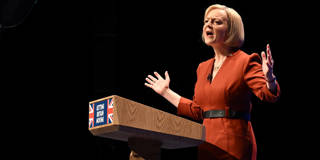The new UK prime minister’s outdated economic plan attempts to apply Thatcher-era solutions to twenty-first-century problems. But lifting Britain’s chronically low growth rate and boosting its flat-lining productivity requires a government that does not shy away from actively shaping markets.
CAMBRIDGE – What is the government’s proper role in an advanced market economy? That is the fundamental question at the heart of the economic debacle in the United Kingdom. So far, the focus has been on Prime Minister Liz Truss’s disastrous macroeconomic judgment and the (entirely understandable) reaction of financial markets to her fiscal plan. But Truss and her Chancellor of the Exchequer, Kwasi Kwarteng, got one thing right: the UK’s core problem is that long-term growth has ground to a halt.
Few would disagree with Truss and Kwarteng’s diagnosis of the UK’s economic challenges. The current confluence of global crises has exposed the country’s chronically low growth rate and flat-lining productivity. But their proposed remedy – cutting taxes for the rich and undoing economic regulations, thereby unleashing innovation and investment – turned out to be a harder sell. Even financial-market traders (hardly statist left-wingers) do not believe in Truss’s vision of a twenty-first-century Hayekian utopia.
When courting rank-and-file Conservative Party members in the contest to replace Boris Johnson, Truss presented herself as Margaret Thatcher redux, copying not only the Iron Lady’s radical right-wing policies but many of her outfits and photo ops. But unlike Thatcher, who was elected in 1979 with a popular mandate and ample political capital, Truss became prime minister by winning over 81,326 Conservative Party members – just 21,000 votes more than her rival, Rishi Sunak. The wider British public remained on the sidelines.

CAMBRIDGE – What is the government’s proper role in an advanced market economy? That is the fundamental question at the heart of the economic debacle in the United Kingdom. So far, the focus has been on Prime Minister Liz Truss’s disastrous macroeconomic judgment and the (entirely understandable) reaction of financial markets to her fiscal plan. But Truss and her Chancellor of the Exchequer, Kwasi Kwarteng, got one thing right: the UK’s core problem is that long-term growth has ground to a halt.
Few would disagree with Truss and Kwarteng’s diagnosis of the UK’s economic challenges. The current confluence of global crises has exposed the country’s chronically low growth rate and flat-lining productivity. But their proposed remedy – cutting taxes for the rich and undoing economic regulations, thereby unleashing innovation and investment – turned out to be a harder sell. Even financial-market traders (hardly statist left-wingers) do not believe in Truss’s vision of a twenty-first-century Hayekian utopia.
When courting rank-and-file Conservative Party members in the contest to replace Boris Johnson, Truss presented herself as Margaret Thatcher redux, copying not only the Iron Lady’s radical right-wing policies but many of her outfits and photo ops. But unlike Thatcher, who was elected in 1979 with a popular mandate and ample political capital, Truss became prime minister by winning over 81,326 Conservative Party members – just 21,000 votes more than her rival, Rishi Sunak. The wider British public remained on the sidelines.